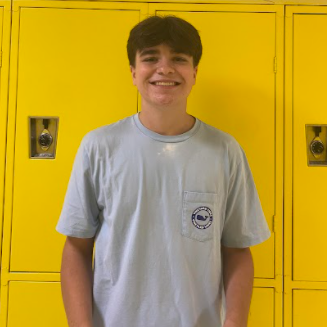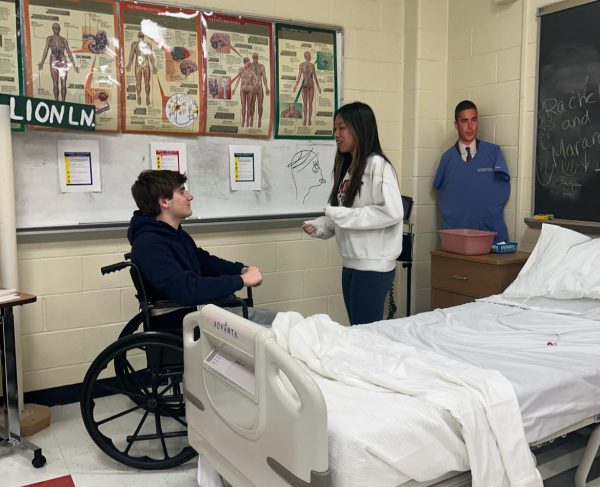Heart Scan Revolution: Cardiac Imaging Takes a Leap
Keeping a Healthy Heart: Track and Field members Basit Iddris, Nate Huebner, and Joseph DeFreitas exercise a healthy heart on a snowy afternoon.
Within the United States, more than five million citizens live with congestive heart failure and an additional 550,000 thousand are diagnosed every year, as reported by Emory Health Care. The condition contributes to 287,000 deaths a year, with more than 50% dying within five years due to complications.
Almost all forms of heart failure can be attributed to the buildup of scar tissue on the heart and the current medical technology only allows for identification of scar tissue after it has begun to form. The limitations of heart-scan technology may delay the identification of scar tissue.
The most common way heart-scan technology has been used to find scar-tissue revolves around the cardiac MRI, or cardiac magnetic resonance imaging. A cardiac MRI utilizes a magnetic field, radio waves, and a computer to provide insight on the status of the heart. A cardiac MRI can show imaging of scar tissue on the heart, but identification only after significant buildup remains ever present.
In response, the University of Edinburgh is spearheading a new system of heart-scanning technology that aims to identify the buildup of scar tissue as it is formed, rather than after the buildup has accumulated. Located in Scotland, the study is being supervised by the university’s chair of clinical cardiology, Professor Marc Dweck.
The study started when the British Heart Foundation provided Dweck with a £671,000 grant (765,000 US dollars). The professor and his team at Edinburgh will be distributing the funds towards this new and advanced heart-scan technology, with the estimated time of the study spanning three years.
Dweck plans to use fibroblast activation protein – positron emission tomography, (FAPI-PET) to tie up the loose ends of this shortcoming. These methods would use radioactive substances known as radiotracers to visualize and measure changes within the heart. They identify chemical reactions within the body in order to better diagnose and treat potential illness.
The study hopes to build on existing forms of cardiac scanning, as well as cutting edge new technology to advance in the race for heart disease/failure treatments. If the study is deemed a success, the technology could be used to identify an even larger range of heart diseases.
In conjunction with the University of Edinburgh, Professor Marc Dweck stated his excitement for the program. He says, “The ability to image scarring in real time, as it is developing in the heart muscle, would be a major scientific advance, which could improve our knowledge about a wide range of heart muscle disorders and speed up the development of new treatments.”
The professor has high hopes that with success in the study will come success in early treatments. The earlier cardiac scarring is caught, the earlier it can be treated, so an advancement like this could potentially save hundreds, or even thousands, of lives.
“Our work hopes to shed important light on scarring that is actually occurring now, at the time of the scan. Is the heart scarred or is it scarring? This in turn will help increase our understanding about how scar develops in the heart and how best to treat patients and prevent the development of heart failure,” explained Dweck to the university.
With new technology rolling out every day, coupled with big time studies like this one, it’s easy to believe that heart disease is becoming less and less of a personal concern for everyday people. Beliefs like this could not be any further from the truth.
Jeffery Raucci, health teacher at Foran High School, is no stranger to the continued awareness of keeping a healthy heart. On top of being versed in the health and wellness field as a health teacher, Raucci coaches cross-country in the fall, boys’ basketball in the winter, and track and field in the spring.
Raucci hopes that Dweck’s studies, as well as all studies on similar grounds help increase the looming threat of heart disease, not simply put us at ease. “These potential breakthroughs are certainly coming at a much-needed time, with cardiovascular disease being our number 1 leading cause of death in America.” Raucci stated.
On top of the simple awareness the study brings, Raucci believes that the practice of a healthy heart can put people out of the danger Dweck’s studies hope to treat. “Exercising at least 45 minutes per day at least 4 days per week, being able to manage stress, and eating more fruits and vegetables instead of trans fats and unhealthy foods are the biggest factors in keeping a healthy heart and healthy lifestyle,” claims Raucci.
While the study Professor Marc Dweck and the University of Edinburgh are conducting may seem groundbreaking, it shouldn’t take people’s attention away from the importance of keeping a healthy heart and promoting cardiovascular fitness. Doctors and researchers are still miles away from a lasting solution to heart disease/failure, and the medical world has only just peered over the horizon of a possible, permanent treatment.
Your donation will support the student journalists of Foran High School. Your contribution will allow us to purchase equipment and cover our annual website hosting costs.

Hi! My name is Luke Thomas and I'm a junior at Foran high School and I’m a member of the Foran golf team along with the Science Olympiad Team....

Hi, my name is Joseph DeFreitas and I'm a senior at Joseph A Foran High School. I participate in indoor and outdoor track, while managing cross country...







